
The Russian Orthodox Church, alternatively legally known as the Moscow Patriarchate, is an autocephalous Eastern Orthodox Christian church. It has 194 dioceses inside Russia. The primate of the ROC is the Patriarch of Moscow and all Rus'.

Stark County is a county in the U.S. state of North Dakota. As of the 2020 census, the population was 33,646, making it the 7th most populous county in North Dakota. Its county seat is Dickinson.
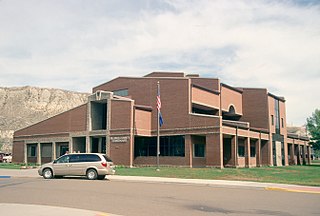
Billings County is a county in the U.S. state of North Dakota. As of the 2020 census, the population was 945, making it the second-least populous county in North Dakota. Its county seat and only incorporated place is Medora.

Dickinson is a city in and the county seat of Stark County, North Dakota, United States. The population was 25,679 at the 2020 census, making it the 7th most populous city in North Dakota. Dickinson is home to the Ukrainian Cultural Institute, which has a museum and holds events year round for the local Ukrainian community. Western North Dakota has a high concentration of people of Ukrainian descent.

The Heart River is a tributary of the Missouri River, approximately 180 miles (290 km) long, in western North Dakota, United States.
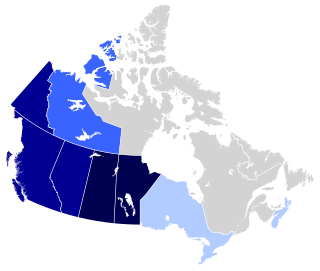
Ukrainian Canadians are Canadian citizens of Ukrainian descent or Ukrainian-born people who immigrated to Canada.
The Russian Greek Catholic Church or Russian Byzantine Catholic Church is a sui iuris Byzantine Rite Eastern Catholic Church of the worldwide Catholic Church. Historically, it represents a both a movement away from the control of the Church by the State and towards the reunion of the Russian Orthodox Church with the Catholic Church. It is in full communion with and subject to the authority of the Pope of Rome as defined by Code of Canons of the Eastern Churches.

Reverend Agapius Honcharenko was a Ukrainian patriot and exiled Orthodox Christian priest. He was a prominent scholar, humanitarian, and early champion for human rights.
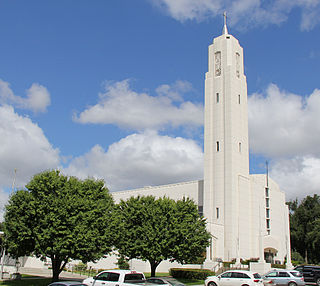
The Diocese of Bismarck is a Latin Church ecclesiastical territory, or diocese, of the Catholic Church in western North Dakota in the United States. It is a suffragan diocese in the ecclesiastical province of the metropolitan Archdiocese of Saint Paul and Minneapolis.
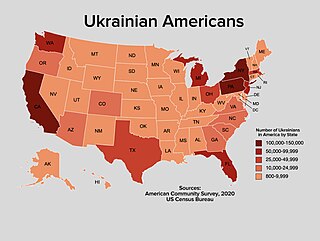
Ukrainian Americans are Americans who are of Ukrainian ancestry. According to U.S. census estimates, in 2021 there were 1,017,586 Americans of Ukrainian descent representing 0.3% of the American population. The Ukrainian population of the United States is thus the second largest outside the former Eastern Bloc; only Canada has a larger Ukrainian community under this definition. According to the 2000 U.S. census, the metropolitan areas with the largest numbers of Ukrainian Americans are: New York City with 160,000; Philadelphia with 60,000; Chicago with 46,000; Detroit with 45,000; Los Angeles with 36,000; Cleveland with 26,000; Sacramento with 20,000; and Indianapolis with 19,000. In 2018, the number of Ukrainian Americans surpassed 1 million.

Ukrainian Village is a Chicago neighborhood located on the near west side of Chicago. Its boundaries are Division Street to the north, Grand Avenue to the south, Western Avenue to the west, and Damen Avenue to the east. It is one of the neighborhoods in the West Town community area, and has one of the largest concentrations of Ukrainians in the United States.

Ukrainian Argentines are Argentine citizens of Ukrainian descent or Ukraine-born people who reside in Argentina. Ukrainian Argentines are an ethnic minority in Argentina. Estimates of the Ukrainian and/or Ukrainian-descended population range from 300,000 to 470,000 people. Many Ukrainian Argentines are of Jewish descent. Currently, the main concentrations of Ukrainians in Argentina are in the Greater Buenos Aires area, with at least 100,000 people of Ukrainian descent, the province of Misiones, with at least 55,000 Ukrainians, and the province of Chaco with at least 30,000 Ukrainians. In Misiones Province Ukrainians constitute approximately 9% of the province's total population. In comparison to Ukrainians in North America, the Ukrainian community in Argentina tends to be more descended from earlier waves of immigration, is poorer, more rural, has less organizational strength, and is more focused on the Church as the center of cultural identity. Most Ukrainian Argentines do not speak the Ukrainian language and have switched to Spanish, although they continue to maintain their ethnic identity.
Byzantine Rite Christianity in Canada refers to all Eastern Orthodox, Eastern Catholic, and independent groups in Canada who use the Byzantine Rite.

Hirschville is an unincorporated community in Dunn County, North Dakota, United States.

The Dickinson Micropolitan Statistical Area, as defined by the United States Census Bureau, is an area consisting of two counties in North Dakota, anchored by the city of Dickinson. As of the 2010 census, the μSA had a population of 24,982.
Gorham is an unincorporated community and ghost town in Billings County, North Dakota, United States. The community was founded c. 1899 and became heavily populated by Ukrainian immigrants. Gorham served as a hub for the rural community, containing a Ukrainian Catholic church, general store, post office, and other businesses. The town was officially abandoned in 1972, although rural farms still exist in the locale.
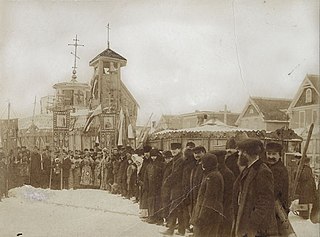
The Tin Can Cathedral was the first independent Ukrainian church in North America. It was the heart of the Seraphimite Church. Founded in Winnipeg, it had no affiliation with any church in Europe.

The Holy Trinity Ukrainian Greek Orthodox Church in Wilton, North Dakota, was built in 1913 to serve the local Eastern Orthodox Ukrainian immigrants in the area. It was listed on the National Register of Historic Places (NRHP) in 1982.

St. Michael the Archangel Ukrainian Catholic Church is a Ukrainian Catholic church located in Baltimore, Maryland. It was founded to initially serve the needs of the Ukrainian immigrant community in Baltimore.



















